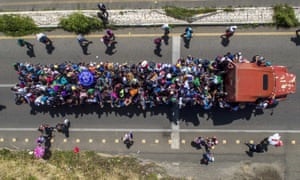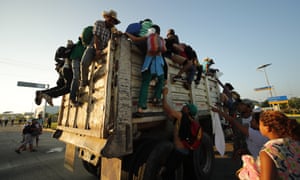Extract from The Guardian
Thousands of Central American migrants are marching through southern Mexico in hopes of reaching the US
Thousands of Central American migrants, including men, women and entire families, are marching through southern Mexico, in the hope of reaching the US.
Mexico’s interior ministry put the figure at 4,500 on Tuesday; local officials in the town Huixtla estimated the number of participants at closer to 6,000, while UN officials said there were 7,200 migrants.
Some people have already abandoned the caravan: 1,699 people have applied for asylum in Mexico, and 495 Hondurans have asked to be repatriated, according to the Mexican government.
Adam Isacson from the Washington Office on Latin America said that US and Mexican statistics show that just 869 people from the “Middle East, Af-Pak and Saharan countries” were detained in the US border zone in 2017 – which represents 0.5% of total apprehensions in Mexico and an even smaller percentage of the US total.

How many people are in the caravan?
The group has grown steadily since setting out from the Honduran city of San Pedro Sula on 12 October, but the exact size is unclear as there is no single organizing group.Mexico’s interior ministry put the figure at 4,500 on Tuesday; local officials in the town Huixtla estimated the number of participants at closer to 6,000, while UN officials said there were 7,200 migrants.
Some people have already abandoned the caravan: 1,699 people have applied for asylum in Mexico, and 495 Hondurans have asked to be repatriated, according to the Mexican government.
Where are they from?
Reporters travelling with the caravan have seen no evidence to support Donald Trump’s allegation that “Middle Easterners” had infiltrated the group, although migrants from Africa and Asia routinely travel through Mexico to reach the US.Adam Isacson from the Washington Office on Latin America said that US and Mexican statistics show that just 869 people from the “Middle East, Af-Pak and Saharan countries” were detained in the US border zone in 2017 – which represents 0.5% of total apprehensions in Mexico and an even smaller percentage of the US total.
Who organized the caravan?
In interviews, Honduran members of the group said that they learned about the caravan from Facebook posts, and a report on the local HCH television station, which erroneously suggested that a former congressman and radio host would cover the costs of the journey.
Why did people join the caravan?
People in the group say they are fleeing grinding poverty, and the violent crime which has helped turn Central America into one of the most dangerous regions of the world.Brian Delarta, 30, a mechanic from La Ceiba, Honduras, showed a pair gunshot wounds in the shoulder and leg – the result of a gang shootout in his neighbourhood, he said. Like many other Honduran migrants, he said that low pay, rising prices for basics such as food, water and electricity and extortion demands from the local gang had made it impossible to make ends meet.
A few Nicaraguan families in the group say they fled their country to escape political unrest and the violent government crackdown which has claimed more than 300 lives.
Migrants say traveling en masse saves them from having to pay a coyote, or people smuggler, and offers some hope of protection from bandits who target migrants for kidnap, extortion and rape, as well as Mexican migration checkpoints which have sprung up across the country.
Where are they going?
No one in the group seems to know exactly which route they will take through Mexico. At the moment, the caravan is moving along the sparsely populated coast of the southern state of Chiapas, more than 1,243 miles (2,000km) from the US border.According to activist Jorge Andrade, migrants used take about 10 days to reach the US, but Mexico’s migration crackdown forces people to take more circuitous – and dangerous – routes, and the journey can now take months.
Who is helping the members of the caravan?
The US vice-president, Mike Pence, has said that the Honduran president, Juan Orlando Hernández, told him that the caravan was being financed by the Venezuelan government, but neither has offered any evidence to support the claim, and reporters traveling with the group have seen no sign of Venezuelan involvement.Instead, most of the practical support has come from ordinary Mexicans, who have given everything from bottled water and clothes to tamales and ice cream to the passing migrants.
Restaurant owner Rafael Gómez served 200 plates of beans, rice and tortillas to the group when they reached the town of Huixtla. “The people with the least are the ones helping the most,” he said.
The local mayor, José Luis Laparra Calderón, said the municipality chipped in with food and drink, and also provided tarpaulin shelters. “There’s no assistance from the federal or state governments,” he said.
Members of the migrant advocacy group Pueblo Sin Fronteras – which organized a similar, though much smaller caravan in April – are accompanying the migrants. But its staff deny any involvement in convening the current caravan.
Members of the caravan say that there is no single organizer.
What challenges will the migrants face?
Red Cross paramedics are treating the marchers for blisters, dehydration and other maladies aggravated by physical exertion in hot and humid conditions.Temperatures in Chiapas have hovered in the low 30s celsius (around 90F) and show little sign of dropping, despite occasional heavy rains.
As it heads north, the group will pass through several zones where violence is rife, and migrants are routinely targeted for extortion or kidnapping. They will also pass through towns which were devastated in last year’s earthquake.
For now, Mexican police appear to be letting the migrants pass by unhindered.
“Their hands are tied,” Mayor Laparra said, who said that a crackdown was unlikely because the large numbers of reporters and human rights observers travelling with the group.
What will happen at the border?
Most of the people who make it to the border are likely to turn themselves in to US authorities and claim asylum, although a few – mostly younger men – have said they will attempt to cross illegally if that is not possible.Trump has said he will not let caravan members in, but the US is legally obliged to consider the cases of asylum seekers.
If they pass the first step of the asylum process, known as a credible fear interview, they will be held in detention or released in the US and face an immigration court months, but more likely years, later.
If they do not pass the screening, or are denied entry to the US on other grounds, they will be deported.
The April caravan of 1,500 people had shrunk to a few hundred by the time it reached the border. Of that group, 401 requested asylum, according to US Citizenship and Immigration Services (USCIS).
Of those, 374 passed the credible fear interview, but the Department of Homeland Security (DHS) said it was not tracking the outcome of their asylum cases. Another 122 tried to enter illegally, but they too are able to apply for asylum and the outcome of their cases is unknown.

No comments:
Post a Comment